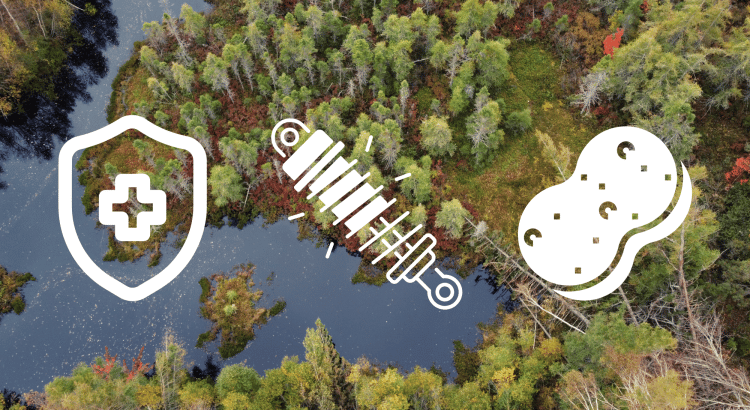‘It could have been worse!’ This is the sentiment lingering in the minds of many Islanders after Hurricane Fiona hit the Island as a powerful post-tropical storm on September 23-24, 2022. Those who saw iconic sand dunes disappear and swaths of forested areas flattened by the winds witnessed the immediate impacts of one of the most damaging events in recent Island history. Nevertheless, the team at Island Nature Trust is striving for a more positive outlook and a regenerative way forward that can give hope to all Islanders.
‘Nature did its job! Intact ecosystems shielded us from the worst effects of this storm, and we should all be extremely grateful for that,’ says INT Executive Director, Bianca McGregor.
‘There certainly is a sense of sadness when Islanders see their sand dunes eroded and stands of fallen trees, but these natural systems were what protected us from the worst effects of post-tropical storm Fiona,’ she adds.
Nature Provides: The ecosystems that protected us during post-tropical storm Fiona
The Island’s Shield: Our coastline is shielded from potentially catastrophic storm surges by the Island’s intact dune systems and krummholz forests. The before and after photos of dune loss on the North shore are shocking, but these iconic ecosystems have protected us all. Home to marram grass and other native plants, healthy dune systems are constantly shifting and act as buffer zones between vulnerable land behind them and the onslaught of the sea.
Krummholz forests act as a natural erosion buffer. The deep root systems and stunted and twisted vegetation of these windswept and salt-battered forest ecosystems hold the sandy coastline together where they still exist in PEI’s windiest spots.
The Island’s Shock Absorbers: In addition to providing a home to a wide range of flora and fauna, healthy, intact forest stands prevent erosion, filter and store water, regulate temperatures, and provide cultural benefits. As wind breaks, they absorbed much of the storm’s destructive energy during Hurricane Fiona. Imagine an island without healthy forest stands – homes would take the full force of the winds, there would be nothing to act as shock absorbers.
The Island’s Sponge: One of the many ecosystem services provided by wetlands is storm protection, which absorbs the wave energy thus dampening storm surges. They slow the speed of wind and flood waters before they reach our properties further inland. This is experienced directly in those areas around our coast where we have in-filled wetlands and built infrastructure in their place and experience regular flooding.
Impact Assessment: The long road to regeneration
In order to support the regeneration of the ecosystems that protect our communities from extreme storm events, staff will conduct impact assessments to inform management plans across the Trust’s 66 natural areas over the next several months.
‘Now is the time to give nature space and time to regenerate’ says Land Stewardship Program Manager, Amy Frost-Wicks.
‘It’s vital that our Island’s ecosystems are allowed to rebuild, recover and regenerate so that they can continue to protect us from destructive storms in the future. Concerning our coastline, we work to foster education on the importance of people staying off the dunes. In our forests, we cut down dead trees that are leaning or hung up in the canopy. The wood is either laid flat to decompose, which rejuvenates the soil, or it is used to build brush piles, which provide wildlife habitat. This opens the canopy, allowing light to reach the forest floor, where it once didn’t, and facilitates natural regeneration. Where necessary, we will help this process along with strategic seeding and planting of native species to enhance biodiversity.’
‘The reality is that we need to facilitate rather than fix.’ continues Amy. ‘It’s a human tendency to want to ‘clean-up’ as quickly as possible. However, cleaning-up and removing fallen trees from natural areas will do more harm than good to the ecosystems that need time to regenerate so they can continue protecting us. Also, doing work too soon after a natural disturbance event like this may pose a risk to human safety, as trees will continue to settle and fall over the winter.’
‘I also can’t stress enough how important it is that the public stay off the areas where sand dunes used to be. We need to let ecosystems begin working their magic. The sand will eventually start shifting and re-establish the natural shield around our coastline. This happens best when there is as little human disturbance as possible,’ Amy adds.
This follow-up stewardship work will cost time and money, so Island Nature Trust is asking Islanders for help. Supporting the Trust’s Mend A Patch campaign will enable Islanders to help restore the natural areas that helped protect us during Hurricane Fiona. Alternatively, the Trust is asking people to consider donating or selling lands with high ecological value to be conserved for future generations and ecosystem services.
Since Hurricane Fiona, Island Nature Trust has had an outpouring of offers to help with the cleanup – we humbly thank Islanders for their support. For those of you wanting to donate your time toward stewardship efforts, we are asking the public to reach out to our Engagement and Outreach Coordinator at jmerth@islandnaturetrust.ca. Johanna will be able to take their information – adding them to our contact list.
While we are confident in the abilities and skills of our trained staff to facilitate ecosystem regeneration in our natural areas. We will be sure to reach out to Islanders if extra hands are required for any of this work, where necessary and when it is safe to do so.
Fundraising initiatives must begin sooner rather than later in order to support restoration work by our staff. In the event that another Fiona strikes before these natural areas have had time to recover, what will we do? Let’s ensure that in the future we can continue to say, ‘it could have been worse.’
Additional Information
In the interest of public safety, all Island Nature Trust natural areas are closed to the public until further notice, while the stewardship team carries out its important impact assessments. We ask that the public respect these closures and not access any of our natural areas until further notice.
Ecosystem services are the many and varied benefits to humans provided by the natural environment and from healthy ecosystems. Such ecosystems include, for example, agroecosystems, forest ecosystems, grassland ecosystems and aquatic ecosystems. Healthy, functioning ecosystems offer services like natural pollination of crops, clean air, extreme weather mitigation, and human mental and physical well-being
About
Island Nature Trust is a membership-based, non-government, Canadian charity dedicated to land conservation in Prince Edward Island since 1979.
In a race against time, our mission is to preserve and steward forever a network of natural areas and wildlife habitats across PEI and bring together those who care about preserving PEI’s natural legacy for future generations.
We are a key provider of technical, science-based knowledge on land stewardship and wildlife in PEI for landowners, governments and partner environmental groups.
We provide mentorship and employment opportunities to people committed to land stewardship, conservation research and wildlife monitoring who will continue building on the long tradition of Island Nature Trust as the premiere land trust on the Island.
Mend A Patch campaign page: www.islandnaturetrust.ca/mend
Facebook: www.facebook.com/islandnaturetrust
Instagram: www.instagram.com/islandnaturetrust/
LinkedIn: www.linkedin.com/company/island-nature-trust
Contacts
Ben Russell – Communications Manager
902-892-7513
ben@islandnaturetrust.ca

